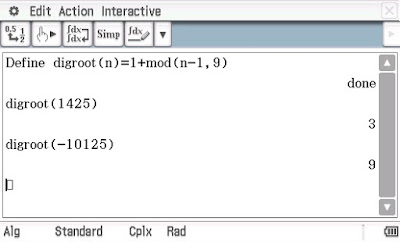Casio Classpad fx-CP400:
Defining Functions
Using the Define command with the Classpad
A lot of formulas can be created using the Define command on
the Casio Classpad. For this blog I am
using the fx-CP400. My preference is to
use the Main application, and call the Define command from the
Action>Command submenu. The
expressions are stored as Functions. If
you want to transfer functions (and programs) from the fx-CP400 to a computer
drive, export them to the Save-F folder first and then connect the Classpad to
the computer.
Fibonacci Numbers
fibon(n) = approx((1+√5)^n – (1-√5)^n)/(2^n * √5)
The approx command is used in order to force a simplified
numerical answer.
Error Function
erf(z) = 2/√π * ∫ (e^-x^2 dx from 0 to z)
I think numerical integrals return approximate answers no
matter what, please correct me if I am wrong.
Digital Root:
Counting all digits of a number, repeating the process until you get a
single digit (0-9)
dr(n) = 1 + mod(n-1, 9)
I could only find the mod function in the catalog. Unlike most Casio calculators, the Classpad’s
mod function accepts negative numbers and non-integers.
Area of a Regular Polygon
aregpoly(n,s) = (n*s^2) / (4 * tan(180°/n))
The degree symbol (°) is needed to allow proper calculation
regardless of angular mode. The degree
symbol is found in the Trig soft menu.
Great Circle: Distance between two places in kilometers
Note:
* In order for the
function to work properly, the Degree mode must be selected.
* You can enter
degrees in terms of degrees, minutes, seconds by choosing the DMS
template. This template is in the Math1
soft keyboard and is represented by three boxes (□ □ □) next to toDMS. You can also call the template by pressing
Action/Interactive, Transformation, DMS, dms.
The dms command’s syntax is
dms(degrees, minutes, seconds) and transforms the input into degree
decimals.
Example:
Los Angeles, N:
34°13’, E: -118°15’; Tokyo, N: 35°41’22.22”, E: 139°42’30.12”
Distance ≈ 8,803.002688 km
Formula (for km):
Distance ≈ cosˉ¹ (sin N1 sin N2 + cos N1 cos N2 cos (E1 – E2))
* 6371 * π / 180
If you want US miles, replace 6371 with 3959.
This blog is property of Edward Shore, 2016.




